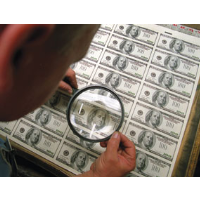Taxpayers to Fork out $3.79 Million in Good Money to Pay for Fed’s $3 Billion of Bad Cash
 (AP Photo)
(AP Photo)
The federal government has been trying for three years to issue a new version of the hundred-dollar bill. But repeated mistakes have delayed putting the new bills into circulation, and the problems may end up consuming millions in tax dollars.
The Federal Reserve would like the new bills to feature a Liberty Bell that changes color, a hidden message on Ben Franklin’s collar, and tiny three-dimensional images that move when the bill is tilted.
When it comes to actually printing the new Ben Franklins, the task belongs to the Department of the Treasury, specifically its Bureau of Engraving and Printing (BEP).
BEP officials have told the Fed that the printing factories have struggled to produce clear versions of the new bill, which have suffered from “mashing”—the application of too much ink on the currency paper.
Before that, other problems delayed the rollout, including bills being printed with a blank spot on them.
The snafus have forced the Fed to return more than 30 million hundred-dollar notes—the equivalent of $3 billion if legally in circulation—and to demand that BEP refund the Fed’s money.
Meanwhile, “another thirty billion dollars’ worth of paper sits in limbo awaiting examination,” according to David Wolman of The New Yorker. The new deadline for BEP to get it right is October 8.
Eric Levenson at The Atlantic Wire estimates that the mistakes have so far cost the U.S. Treasury about $3.79 million.
-Noel Brinkerhoff
To Learn More:
A Blunder at the Money Factory (by David Wolman, New Yorker)
How Much Will It Cost to Dispose of 30 Million Defective $100 Bills? (by Eric Levenson, Atlantic Wire)
- Top Stories
- Unusual News
- Where is the Money Going?
- Controversies
- U.S. and the World
- Appointments and Resignations
- Latest News
- Musk and Trump Fire Members of Congress
- Trump Calls for Violent Street Demonstrations Against Himself
- Trump Changes Name of Republican Party
- The 2024 Election By the Numbers
- Bashar al-Assad—The Fall of a Rabid AntiSemite






Comments